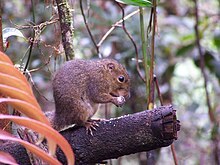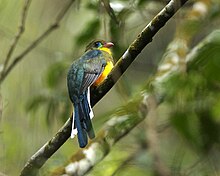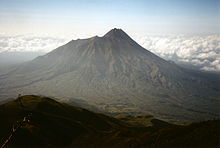Kinabalu mountain
Posted: Senin, 01 Oktober 2012 by Afif 'Davit' Afriza in Label: biology, climbing route, ecology, fauna, flora, geography, geology, gunung, gunung berapi, historyMount Kinabalu (Malay: Gunung Kinabalu) is a prominent mountain on the island of Borneo in Southeast Asia. It is located in the East Malaysian state of Sabah and is protected as Kinabalu National Park, a World Heritage Site. Kinabalu is the highest peak in Borneo's Crocker Range and is the highest mountain in the Malay Archipelago. Mount Kinabalu is also the 20th most prominent mountain in the world by topographic prominence.
In 1997, a re-survey using satellite technology established its
summit (known as Low’s Peak) height at 4,095 metres (13,435 ft) above
sea level, which is some 6 metres (20 ft) less than the previously
thought and hitherto published figure of 4,101 metres (13,455 ft).
Mount Kinabalu includes the Kinabalu montane alpine meadows ecoregion in the montane grasslands and shrublands biome.
The mountain and its surroundings are among the most important
biological sites in the world, with over 4500 species of plant, 326
species of birds, and 100 mammalian species identified. Among this rich collection of wildlife are famous species such as the gigantic Rafflesia plants and the orangutan. Mount Kinabalu has been accorded UNESCO World Heritage status.
Low's Peak can be climbed quite easily by a person in good physical condition and there is no need for mountaineering equipment at any point on the main route. Other peaks along the massif, however, require rock climbing skills.
Contents |
Biology
Significantly, Mount Kinabalu along with other upland areas of the Crocker Range is well-known worldwide for its tremendous botanical and biological species biodiversity with plants of Himalayan, Australasian, and Indomalayan origin. A recent botanical survey of the mountain estimated a staggering 5,000 to 6,000 plant species (excluding mosses and liverworts but including ferns),[3][6][7][8][9][10] which is more than all of Europe and North America (excluding tropical regions of Mexico) combined. It is therefore one of the world's most important biological sites.Flora
The flora covers the mountain in zones of different types of habitat as one climbs up, beginning with a lowland belt of fig trees and insectivorous pitcher plants. Then between 2,600 to 3,200 m (8,530 to 10,499 ft) is a layer of short trees such the conifer Dacrydium gibbsiae and dwarf shrubs, mosses, lichens, liverworts, and ferns. Finally many of the world's richest variety of orchids are found on the high rockier slopes.
Its incredible biodiversity in plant life is due to a combination of several unique factors: its setting in one of the richest plant regions of the world (the tropical biogeographical region known as western Malesia which comprises the island of Sumatra, the Malay Peninsula, and the island of Borneo), the fact that the mountain covers a wide climatic range from near sea level to freezing ground conditions near the summit, the jagged terrain and diversity of rocks and soils, the high levels of rainfall (averaging about 2,700 millimetres (110 in) a year at park HQ), and the climatic instability caused by periods of glaciation and catastrophic droughts which result in evolution and speciation. This diversity is greatest in the lowland regions (consisting of lowland dipterocarp forests, so called because the tree family Dipterocarpaceae are dominant). However, most of Kinabalu’s endemic species are found in the mountain forests, particularly on ultramafic soils (i.e. soils which are low in phosphates and high in iron and metals poisonous to many plants; this high toxic content gave rise to the development of distinctive plant species found nowhere else).
Fauna

Endemic annelids number less than a dozen known species but include the Kinabalu giant red leech that preys on various earthworms, including the Kinabalu giant earthworm.
Threats and preservation
The steep mountainsides with poor soil are not suitable for farming or for the timber industry so the habitats and animal life of Kinabalu remain largely intact, with about a third of the original habitat now degraded. Kinabalu Park was established in 1964 and the nearby mountains were protected as the Crocker Range National Park in 1984. However even national park status does not guarantee full protection, as logging permits were granted on Trus Madi in 1984.Geology
Mount Kinabalu is essentially a massive pluton formed from granodiorite which is intrusive into sedimentary and ultrabasic rocks, and forms the central part, or core, of the Kinabalu massif. The granodiorite is intrusive into strongly folded strata, probably of Eocene to Miocene age, and associated ultrabasic and basic igneous rocks. It was pushed up from the earth’s crust as molten rock millions of years ago. In geological terms, it is a very young mountain as the granodiorite cooled and hardened only about 10 million years ago. The present landform is considered to be a mid-Pliocene peneplain, arched and deeply dissected, through which the Kinabalu granodiorite body has risen in isostatic adjustment. It is still pushing up at the rate of 5 mm per annum. During the Pleistocene Epoch of about 100,000 years ago, the massive mountain was covered by huge sheets of ice and glaciers which flowed down its slopes, scouring its surface in the process and creating the 1,800-metre (5,900 ft) deep Low's Gully (named after Hugh Low) on its north side. Its granite composition and the glacial formative processes are readily apparent when viewing its craggy rocky peaks.History
British colonial administrator Hugh Low made the first recorded ascent of Mount Kinabalu's summit plateau in March 1851. Low did not scale the mountain's highest peak, however, considering it "inaccessible to any but winged animals". In April and July 1858, Low was accompanied on two further ascents by Spenser St. John, the British Consul in Brunei. The highest point of Mount Kinabalu was finally reached in 1888 by zoologist John Whitehead. British botanist Lilian Gibbs became the first woman and the first botanist to summit Mount Kinabalu in February 1910.Botanist E. J. H. Corner led two important expeditions of the Royal Society of Great Britain to the mountain in 1961 and 1964. Kinabalu National Park was established in 1964. The park was designated a natural World Heritage Site in 2000.
Climbing route
Climbers must be accompanied by accredited guides at all times due to national park regulations. There are two main starting points for the climb: the Timpohon Gate (located 5.5 km from Kinabalu Park Headquarters, at an altitude of 1,866 metres (6,122 ft)),and the Mesilau Nature Resort. The latter starting point is slightly higher in elevation, but crosses a ridge, adding about two kilometres to the ascent and making the total elevation gain slightly higher. The two trails meet about two kilometres before Laban Rata.Accommodation is available inside the park or outside near the headquarters. Sabah Parks has privatized Mount Kinabalu activities to an organization called Sutera Sanctuary Lodges (also known as Sutera Harbour). The mountain may be climbed on a single day trip, or hikers may (usually) stay one night at Laban Rata Resthouse at 3,270 metres (10,730 ft) in order to complete the climb in 2 days, finishing the ascent and descending on the second day. The majority of climbers begin the ascent on day one of a two day hike from Timpohon gate at 1,866 metres (6,122 ft), reaching this location either by minibus or by walking, and then walk to Laban Rata. Most people accomplish this part of the climb in 3 to 6 hours. Since there are no roads, the supplies for the Laban Rata Resthouse are carried by porters, who bring up to 30 kilograms of supplies on their backs. Hot food and beverages are available at Laban Rata, but there is no hot water in the bathrooms and whilst the dining area is heated, the rooms are not. The last 2 kilometres (6,600 ft), from the Laban Rata Resthouse at 3,270 metres (10,730 ft) to Low's Peak (summit) at 4,095.2 metres (13,436 ft), takes between 2 and 4 hours. The last part of the climb is on naked granite rock.
Given the high altitude, some people may suffer from altitude sickness and should return immediately to the bottom of the mountain, as breathing and any further movement becomes increasingly difficult.[18]
Low's gully
Low's Gully (named after Hugh Low) is a 1,800-metre (5,900 ft) deep gorge on the north side of Mount Kinabalu, one of the least explored and most inhospitable places on earth. In 1994 two British Army officers were severely criticised after having led a party of 10 adventurers that required extensive rescue efforts from both the RAF and the Malaysian army. Five members of the party were trapped for 16 days and did not eat for five days before being rescued. The breakaway party of five successfully completed the world's first descent of the gully in three days.Tales

The first derivation of the word Kinabalu is extracted from the short form for the Kadazan Dusun word 'Aki Nabalu', meaning "the revered place of the dead".
The second source states that the name "Kinabalu" actually means "Cina Balu" (which would fully mean "A Chinese Widow"). Due to the lingual influence among the Kadazan Dusun of Sabah, the pronunciation for the word "cina" (chee-na) was changed to "Kina" (kee-na).
It was told that a Chinese prince, was cast away to Borneo when his ship sank in the middle of the South China Sea. He was subsequently rescued by the natives from a nearby village. As he recovered, he was slowly accepted as one of the people of the village. Eventually, he fell in love with a local woman, and married her. Years went by, and he started to feel homesick. So he asked permission from his newly-found family to go back to China to visit his parents (the Emperor and Empress of China). To his wife, he promised that as soon as he was done with his family duties in China, he would come back to Borneo to take her and their children back to China.
When he made his return to China, he was given a grand welcome by his family. However, to his dismay, his parents disagreed with him about taking his Bornean wife back to China. Worse, they told him that he was already betrothed to a princess of a neighbouring kingdom. Having no choice (due to high respect towards his parents), he obeyed with a heavy heart.
Meanwhile, back in Borneo, his wife grew more and more anxious. Eventually, she decided that she will wait for her husband's ship. However, since the village was situated far away from the coast, she couldn't afford to come to the shore and wait for him daily. Instead she decided to climb to the top of the highest mountain near her village, so that she could have a better view of the ships sailing in the South China Sea. Thus, she was then seen climbing up the mountain at every sunrise, returning only at night to attend to her growing children.
Eventually her efforts took their toll. She fell ill, and died at the top of the cold mountain while waiting for her husband. The spirit of the mountain, having observed her for years, was extremely touched by her loyalty towards her husband. Out of admiration for this woman, the spirit of the mountain turned her into a stone. Her face was made to face the South China Sea, so that she could wait forever for her dear husband's return.
The people in her hometown who heard about this were also gravely touched by this. Thus, they decided to name the mountain "Kinabalu" in remembrance of her. To them, the mountain is a symbol of the everlasting love and loyalty that should be taken as a good example by women.
Local legend among the people of Ranau, a district in Sabah, has it that St. John's Peak was the stone which her body was turned into.






















